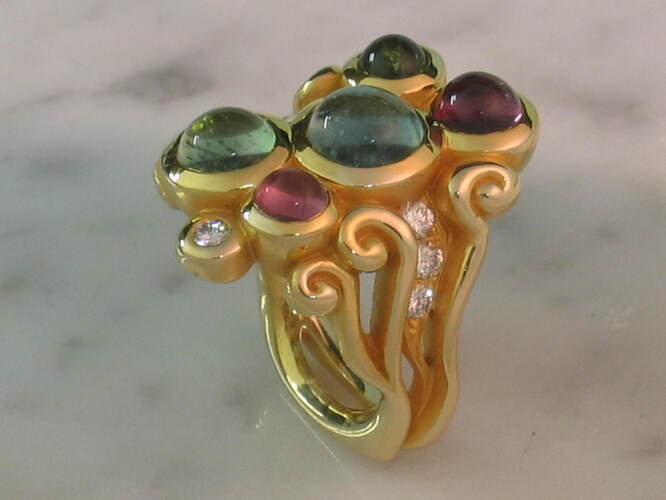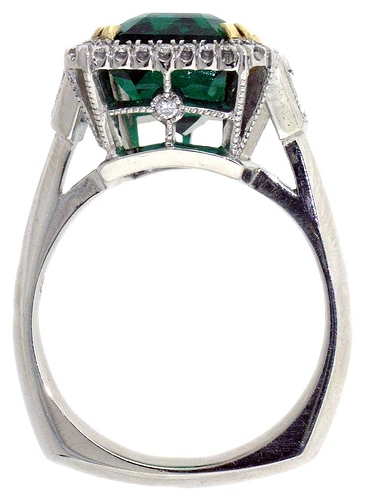How much do you use for 1/2 lb mix with water ?.
Hi Brian
I’m assuming your question is how much water should be mixed with 1/2
lb of investment. The normal proportions is to add investment to 40%
of its weight in water. This makes the water content of the mixture a
little under 30%. I weigh out both my investment and mixing water
because it is more accurate than using volumetric measure. I also
work in metric measures with digital scales accurate to 1 gram. 1/2
lb of investment is roughly 225 grams and this would need to be added
to 90 grams (90ml) of water and mixed. For this sort of work it is
much easier to work in metric measures.
All the best
Jenifer Gow
I use Kerr Satin Cast 20 and they recommend for my tall flask (5" x
3.5") 2lb of investment and 344ml of distilled water., for my short
flask (3" x 3.5") 1.5lb of investment and 274ml of water, and for my
small flask (3" x 2.5") 12oz of investment, 136ml of water.
The Kerr company has a detailed chart on their website (in a. pdf)
but I suck so bad in math, I just called them and told them I was
too stupid to read their charts and had the tech guys there walk me
through the numbers for my individual needs.
The ratios of investment to water makes the difference between a
good casting with no porosity and no flashing, and a bad casting.
There’s no wiggle room.
I use a Pyrex graduated measuring cylinder and am cognizant of the
concave meniscus created by water in glass.
The meniscus is the curve seen at the top of a liquid in response to
its container. One must measure so that the line you are reading is
even with the center of the meniscus. For water and most liquids,
this is the bottom of the meniscus.
I have a mixing casting chart. I would share if anyone is
interested.
Andy “The Tool Guy” Kroungold
I wonder how long investment lasts. I have some that has not been
used for several years… is there a way to test is w/out wasting
wax…thanks in advance…
To have the best results when figuring out ratios of water and
investment isto use a chart that tells how much water in cc’s for
the size flask you areusing, multiply that measurement by 2.5, that
is the grams of investment. Cubic centimeters (cc) and milliliters
are equal. I totally suck at math, this system works! Measuring
water in those plastic containers with milliliterand cc marking is
VERY inaccurate. I used to do 9 3" x 7" flasks with 50-75 pieces in
each flask three times a week, for about 12 years, over a million
pieces cast. Weigh water, weigh investment, accurate method. I mix
water and investment for 1 1/2 minutes, vacuum mixed investment for
1 1/2 minutes, pour into flask, vacuum for 1 1/2 minutes.
Folks here are going to be horrified, but Tim and I don’t measure
and we use tap water.
We mix with our fingers. Yup. Our formula is to mix investment and
cold tap water the thickness of Belgian waffle batter. Not waffle
batter, but Belgian waffle batter. Just a tiny hair thinner than
waffle batter.
We vacuum twice. Once in the bowl and once in the flask.
We buy big barrels of investment. It takes us a while to go through
them.
I like to roll a closed barrel periodically to keep the different
particles well mixed.
We always get great results.
The last time we lost a casting was years ago when our kiln went
crazy and melted the flasks.
I know. So low tech. But it has worked for us for decades.
Have fun and make lots of jewelry.
Jo Haemer
timothywgreen.com
Folks here are going to be horrified, but Tim and I don't measure and we use tap water.
We vacuum twice. Once in the bowl and once in the flask.
I vacuum twice too, just like you. Speaking of being horrified. My
thermocouple went south many years ago and I just stopped worrying
about temperature.
I turn my oven on high, and when the flask is just under glowing I
turn it off. Then when it’s looking right, I cast.
I’ve recently got a hold of a temperature thingy and discovered I was
casting at around 900-1000 F. by eye.
Paf Dvorak
How much do you use for 1/2 lb mix with water?
I recommend contacting the manufacturer of the investment and asking
them to teach you how to correctly mix their product.
Ratios are critical.
Paf Dvorak
I would love to see your mixing casting chart!
This is from a 2013 thread, so I’m not sure someone is going to answer from that era? Lots has happened with investment since then.
I used Satin Cast 20 for decades, but have switched to Ransom and Randolph Ultra-Vest investment with Bandust (helps keep the dust down, so is safer to use) and am quite happy with it.
Ransom and Randolph has an investment mixing calculation page for all of their investments on their website. They have calculation formulas to do the math yourself or you can download an auto-fill calculator, where you input the size of your flask and the auto-calculator tells you everything that you need to know.
Hope that helps!
Jeff
Thank you so much!
At the risk of seeming sacrilegious and horrifying my Ganoksin homies… and I will add the disclaimer from the show Jack Ass, “Do not try this at home. These stunts were performed by professionals.”
My husband Timothy Green and I don’t measure or weigh our investment media or water. No fancy mixer, thermometer, or timer. Never. We just dump what we think is the right amount of investment plaster for the flasks at hand into a rubber bowl. We then add ice cold tap water and mix with our hands until the investment ha the consistency of Belgian waffle or crepe batter. NOT pancake batter. It’s too thick. It’s all by feel. thus mixing by hand. In roughly100 years of combined experience we’ve never had a casting failure.
Well except once when our burnout oven lost it’s mind and over rode the thermostat during an overnight burn out. We we went into the studio the next AM the kiln was glowing red. It was so hot that the flasks had started to melt. It scared the s**t out of us. It was a week before Xmas and we had I think 4 flasks in there. We managed to save all but one.
Jo
So interesting! I recently read that the investment mix should be as thick as sour cream!!!
I guess everyone has their own methods.
Are you casting all different shapes and thicknesses?
I’ve been taught so many different ways to mix investment over the years, I lose track. What I’ve learned is that investment is forgiving and can usually tolerate eyeballing it a bit. For many years, I mixed investment the way Jo does it, by feel, and truthfully sometimes I still do.
Things changed for me about 25 years ago, when I got two bad boxes of investment from the same lot. I did all of the casting for a 4 person jewelry shop and suddenly everyone was mad at me when their castings stopped coming out perfectly. It took forever to figure it out that it wasn’t just a bad box of investment, but the whole pallet of investment at the jewelry supply company was bad.
At some point in trying to figure out what the problem was, I met with a person from Kerr (I was using Kerr Satin Cast). He convinced me that measuring the water to powder ratio and following Kerr’s mixing and burnout instructions exactly was the way to go.
Now I do that. It’s actually easier and quicker, at least for me.
As I teacher, regularly teaching students how to cast for the first time, I definitely recommend following the investment manufacturer’s instructions. Once you get to the place that you’ve mixed zillions of investment flasks, then you know how to mix by feel.
At the school where I teach, we’ve created a chart for each size flask that we own that shows how much water and powder is needed for that size flask. It’s super simple.
I often say that sometimes there’s 15 totally different answers to the same question and they’re all correct. This is definitely one of those moments!
Jeff

